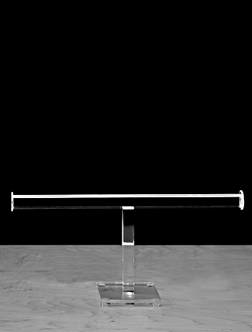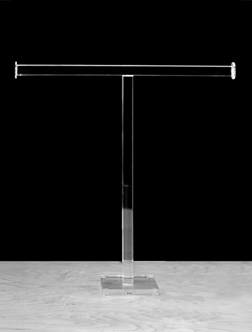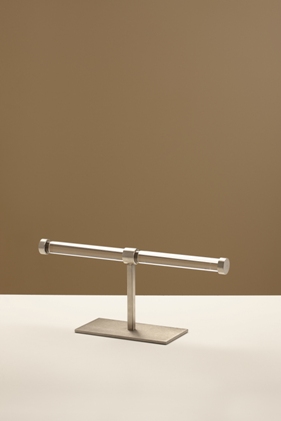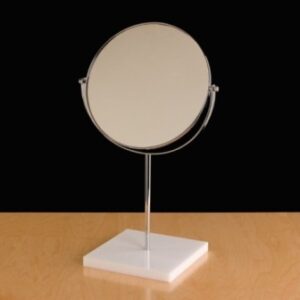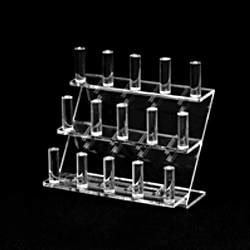For more than 90 years, we have offered the most exceptional and innovative designs in metal retail displays, acrylic jewelry displays and counter top display mirrors. Stocking your retail store has never been easier with quality retail store fixtures from Melvin S. Roos & Co., Inc.
Clear Acrylic Hat Displays
$30.70Counter Top Mirrors – Bronze
$77.86Counter Top Mirrors – Round
$82.51 – $87.17
Title: How to Create a Jewelry Display That Sells
Alt Title: The Art of Selling Your Jewelry Through Visual Merchandising
You’ve stocked your retail store with unique and fashionable jewelry you know your customers will love. But stocking your store is only part of the equation. To move inventory, you’ll have to display your jewelry in a way that will catch your customer’s eye and show your jewelry in the best light – both literally and figuratively. Here’s how to create a retail jewelry display that will not only attract customers but will keep them coming back for more.
The History of Visual Merchandising
Visual merchandising has an interesting history, with roots in the mid-19th century. Like so many commodities we use today, the art of visual selling took shape in the Industrial Revolution.
Before the 1850s, the vast majority of sales were to wholesalers, not customers. Shop owners had little incentive to create artful and attractive displays for their patrons, who were primarily business owners themselves. By the last few years of the 19th century, however, stores had switched to selling their wares directly to consumers.
In 1883, Harry Gordon Selfridge of Marshall Field and Co. sparked a retail revolution when he added revolving doors and large windows for displaying goods to the company’s flagship store in Chicago. It was then that the art of window trimming was born.
Throughout the first half of the 20th century, famous artists found work creating retail window displays. In fact, Andy Warhol worked his first job as a display artist for Hornes Department store, while he was still a student at the Carnegie Institute of Technology.
The Shift to Interior Displays
The beginning and middle of the 20th century brought the phenomenon known as suburban sprawl. Thanks to innovations in transportation, families began to move away from city centers to raise their children in the quiet tranquility of neighborhoods. As families marched into the suburbs and began to create their white picket fences and Neighborhood Watches, retailers followed. Hence, the suburban shopping mall was born.
Shopping malls were more often than not windowless, leading retailers to shift their focus to interior displays. As shopping malls developed, store owners became just as interested in making their stores as beautiful from the inside as they were from the display window.
Today, retail displays are a part of a brand’s personality and a visual representation of how a company differentiates itself from the competition. Most companies use research into their target market to create catered designs and advertising to draw in their customers and foster brand loyalty. That’s a tall order for a display!
Creating the Perfect Display for Your Jewelry
Jewelry has always been a spectacular and fantastical industry, one of the few that inspires wonder and awe in its clientele. Customers don’t buy jewelry in the way they purchase a hat or a pair of gloves – it’s purely a fashion statement. Since ancient times, jewelry has communicated rank or status. Since the 1960s, however, innovations in plastics and non-precious metals have switched jewelry from a privilege for the elite to a form of personal style, accessible to the masses.
Anyone in the jewelry industry knows that, while spectacular and profitable, running a retail store takes tireless effort and hard work. And like any other business, every detail counts.
Visual Merchandising and Your Jewelry Display
Your jewelry display should have its own personal style and reflect your customer’s values, from the window displays to the interior exhibits. Lighting, color, and storytelling are all essential to turning prospects into customers and customers into brand loyalists. There are a set of accepted best practices that create visual interest and drive sales. Creating a winning jewelry display consists of a few parts. Here are some strategies to consider:
- Pick a theme and tell your story. Each company has its own story to tell, and the story usually helps the company relate to its customers. Are you selling luxury or communicating wealth? Do you pride yourself on selling accessible jewelry to the people? What kind of feeling do you want to evoke when people walk into your door? This will drive your retail display decisions. For example, if your brand’s mission is to use all sustainable precious metals, create a window display made with organic materials (think hemp or burlap) or LED lightbulbs.
- Rotate your displays based on the season. Your store may evolve or change based on the season – for example, a Christmas or Valentine’s display may feature bold red backdrops, while Mother’s Day displays will have softer hues.
- Pay attention to lighting, color, and the visual interest of your pieces. Displaying your jewelry requires special attention to lighting, not just your display cases but also your interior lights in general.
- Evenly distribute your jewelry by theme, popularity, or other means. The arrangement of your displays will either entice or distract your customers, depending on your approach.
- Make the most of your available space. Most retail stores are cramped, and jewelry stores are no exception. Making the most of your space will ensure your customers have enough room to maneuver and marvel at your pieces.
- Use props, where applicable. The smallest touches can elevate your store experience and make people connect with your pieces, enticing them to buy.
- Pay attention to the music and smell of your store. Displays are only part of the puzzle – your playlist and scent are the finishing pieces.
Each of these practices plays an important role in creating your jewelry display. Let’s look at each of them in more detail (and how to apply them to your business).
Let Your Jewelry Display Tell Your Brand Story
First impressions matter. When creating a window display, think about your target market and how it relates to your brand. Do you attract a certain buyer persona, like an eco-minded millennial? Or are your customers chic women with timeless style? With your first option, glass displays and racks might be best. For the chic fashionista, think more silver hues.
You likely already have information about your target market and buyer personas. Use this information to guide the first decisions regarding your jewelry displays. Remember, you want your branding consistent throughout your advertising and retail store – your displays are no exception.
Rotate Your Displays Based on the Season
Fashion trends evolve throughout the season and so should your displays. Here’s an example: Fall colors tend to be earth-toned, which can be dull on displays intended for bolder, more colorful pieces.
It’s fine to use the same jewelry racks and pieces throughout the year, but consider tailoring one section of your store – like your window display – to the themes throughout the year. While fall’s earth tones may benefit from glass or silver displays, the cool tones that come with winter look best on black or velour displays. The key is to keep the season’s trends in the back of your mind as you create seasonal displays.
Light, Color, and Visual Interest
Creating a jewelry display is all about communicating a mood. Your lighting and color scheme will help make your jewelry shine and entice your customers to buy.
A good rule of thumb is to look at what the biggest brands are doing in your industry. For example, if you sell high-end jewelry, spend some time researching Tiffany & Co.; it uses a lot of glass, white, and bright lighting, with splashes of its trademark robin’s egg blue. This allows Tiffany to stay true to its brand, but it also lets the dazzling jewelry speak for itself with little interference.
If you’re in the business of selling trendy fashion jewelry that’s not premium or high end, you can have a little more fun displaying it. Think outside traditional glass displays and put jewelry racks on top of artfully stacked wooden boxes or on a mixed media piece, for example.
Distributing Jewelry Throughout Your Store
Walk through your nearest department store, and you’ll likely spot a few themes: There’s men’s clothing and women’s clothing, and those departments are lumped together by dresses, casual bottoms, dress bottoms, and so on. Your jewelry store should be no different. Organizing your jewelry displays by theme will create an interesting shopping experience, but the theme itself is up to you. Here are a couple of considerations:
- Group by product category. For example, situate earrings in one area, bracelets in another, necklaces and rings in a third. This may make finding products easier, but it could limit browsing or impulse buys.
- Avoid putting all your best-selling merchandise together in an artful display, even though it seems like a natural impulse. Instead, put “hidden gems” throughout the store, which will keep your customers moving from one display to the next. You don’t want customers to see your most attractive offerings, only be struck with decision paralysis. In retail, this is a “choice paradox,” and it can actually have a negative effect on your sales.
- Have “employee recommendations” throughout the store. You hired your employees because they were responsible, creative individuals with a passion for jewelry. Why not use that to your advantage? Have employees choose their favorite seasonal piece and do a little write-up about what they love about it and how they suggest wearing it. This keeps both your customer and employee engaged in your store – a win-win!
As far as display pieces go, look at magazines for stores that are similar to your own. Shadow boxes and racks work well, as varying heights create visual interest. If you’re interested in a more minimalist design, choose products that match and give your displays a sense of uniformity.
Making the Most of Your Available Space
The square footage of your store isn’t the same as your available space. On average, stores lose up to 40% of their available space because of office space, back rooms, restrooms, and other facilities. Jewelry display cases, on the other hand, only take up about 10% of total square footage.
To display as much inventory as possible, some stores think they’re making the most of their space by investing in many showcases. Unfortunately, this leads to visual confusion. Rather than relying on rows and rows of showcases – which leads to the choice paradox we talked about earlier – choose one focal point for your display, and use key areas of interest to guide a shopper from one area to the next.
Use Props
One easy way to create key areas of interest is to incorporate props. This also helps evoke your brand theme and construct a shopping experience. Here’s an example: If your store sells vintage pieces, displaying a broach on top of a vintage leather-bound book will transport your customer to the era in which it was made. Old newspapers or postcards also work well for vintage pieces.
While props can tie your displays together, be wary of using too many. Remember, you want your jewelry to steal the show.
The Little Details
Finally, the finishing touches will accent your retail jewelry display and make customers return to your store again and again. Your store’s scent may be more important in evoking a mood than you might think. If your store is minimalist in design and sells high-end merchandise, your best bet will be clean scents like cotton or linen. If, on the other hand, you sell fashion jewelry and rotate merchandise based on the trends of the season, you can have a little more fun with scents (think plumeria, citrus, or cherry blossom). Vintage stores will thrive with smells of warm vanilla or sandalwood.
Your playlist can also create an experience. Some owners choose to tune into the local radio, while others rely on classic crooners or even ’80s love ballads. Whatever music you choose, make sure it’s in line with your store’s brand.
The Final Word
Creating a jewelry display requires careful consideration of your brand, your target audience, and your goals as a company. Using a variety of techniques will keep your customers engaged and moving from display to display throughout the store. Using a mix of materials can maintain visual interest. Using the techniques we’ve outlined above, you not only entice a customer into a sale – but many more in the years to come. Happy selling!

